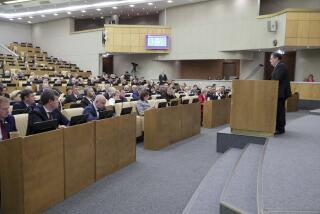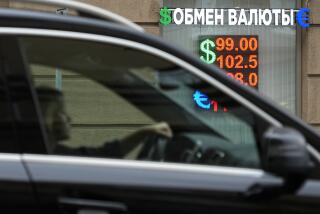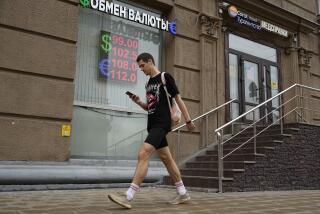Soviets Sharply Devalue Ruble in Move to Crush Currency Black Market
- Share via
MOSCOW — The Soviet government, attempting to wipe out the country’s powerful black market, sharply devalued its currency Wednesday in one of the toughest decisions yet in its economic reform program.
The Soviet ruble officially will still be worth $1.70 on paper. But anyone with U.S. dollars or other hard currencies will be able to buy rubles from the Soviet State Bank for less than 4 U.S. cents or the equivalent. Until now, the rate of exchange for tourists had been 17 cents per ruble.
The devaluation, part of a series of harsh measures drafted by Prime Minister Valentin S. Pavlov to pull the country out of its economic crisis, is aimed at keeping the State Bank’s tourist rate at roughly that of the black market, thus, bringing more hard currency to the state to finance imports.
If successful, the measure should also help arrest the disintegration of the Soviet economy, which has been further weakened by the ruble’s decline. Long worthless outside the country, the ruble has bought less and less even in the Soviet capital; it is increasingly ceasing to be a means of payment.
But the government decision, coming after the doubling and tripling of prices for many food and consumer goods this week, had a tremendous psychological impact for Soviet citizens who are painfully coming to understand how poor they and their country are.
“The State Bank’s measure is not a step toward making the ruble convertible,” the widely read liberal newspaper Komsomolskaya Pravda said. “It is a new trick to dig deeper into the pockets of Soviet citizens.”
With the new exchange rate, “the hard currency equivalent of the average monthly income of the Soviet citizen . . . is $12, much lower than the earnings of the poorest sections of the population, say, in poverty-stricken Papua or Mozambique,” the paper said bitterly.
Soviets going abroad on private visits under liberalized travel regulations will be able to buy only $200 in foreign currency each--at a price of 5,520 rubles, or roughly 20 months’ pay for the average worker. Emigrants will be permitted to buy only $100 in foreign currency before leaving.
Yet these limits on the amount of foreign currency that a Soviet citizen can purchase, as well as the mounting uncertainty about the country’s future, could well keep demand very strong for black market dollars--and force the government into even greater devaluations.
The new rate, officially dubbed the “auction” or “market” rate, will change twice a week after currency auctions at the Soviet State Bank, said Alexander Polyakov, a manager at the Bank for Foreign Economic Activities, the government’s foreign trade bank.
The starting rate of 27.6 rubles to the dollar was fixed after an initial auction Monday, Polyakov said, and it replaced the “tourist rate” of 5.8 rubles to the dollar, established in November, 1989, for tourists, foreigners living in the Soviet Union and Soviets needing hard currency to travel abroad.
Two other exchange rates were not immediately affected: the commercial rate of 57 cents per ruble, used for most foreign business transactions, or the official rate of 1.70 rubles to the dollar, still used in some transactions and for international statistical comparisons.
“We hope that (the black market) will start to fade,” Oleg Mozhaiskov, head of the currency department at Gosbank, told the government newspaper Izvestia. “I don’t see why Soviets and foreigners should go to dubious dealers, taking risks and sometimes even risking their lives, rather than go to the bank to sell their hard currency. After all, the rate is not too bad.”
More to Read
Sign up for Essential California
The most important California stories and recommendations in your inbox every morning.
You may occasionally receive promotional content from the Los Angeles Times.













